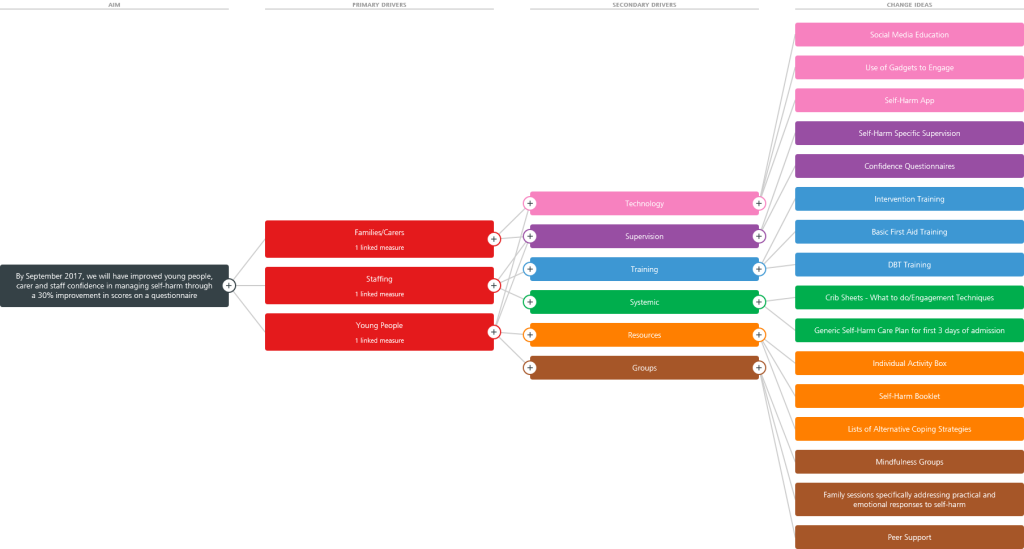
Improving confidence in Managing Self-harm at the Coborn: A QI project supporting young people, their families and staff
20th July 2017
By Louisa Bravery, Consultant Psychologist at the Coborn Centre for Adolescent Mental Health
Introduction
There has been an increase in the number of young people presenting with self-harm difficulties, with a rise in those requiring hospital treatment (NHS Digital cited in The Guardian, 2016). There is also an increasing awareness of the use of social media and growing evidence that interactions with a peer group can increase self-harming behaviour (Hawton, Saunders and O’Connor, 2012). As many young people admitted to the Coborn Unit present with self-harming behaviour, we wanted to take into account some of these contextual factors. Therefore, a Quality Improvement project began in September 2016 when a group of staff initially met with Emma Binley, the QI Coach to decide upon an overall aim.
Aim of QI project
The agreed aim of the QI project is to increase the confidence in three groups: young people, their families and carers and staff in managing self-harm. We aimed for a 30% improvement in scores on a questionnaire over the period of a year.
When considering the goal, we wanted to consider feedback from young people that they feel worried that professionals, and their families or carers, would expect them to stop harming themselves immediately. We also wanted to acknowledge that young people at the Coborn self-harm in order to cope with extremely overwhelming feelings, often in the context of significant life events. As this coping strategy has often developed over a long period of time, we believe that our service can play an important role in helping the young person to understand why they harm themselves, and support them in the initial stages of recovery.
Focus groups
Firstly, we held focus groups with young people, their parents/carers and staff. The focus groups had two aims:
▪ To elicit change ideas: Each of the three groups were asked what they thought would be helpful in increasing their confidence in dealing with self-harm.
▪To develop the questionnaires which capture levels of confidence and knowledge when responding to young people who have harmed themselves.
Change ideas
The change ideas are summarised in the driver diagram below. Here are a few examples:
▪The staff group suggested that they would benefit from further training on how to work therapeutically with young people who self-harm, and consider the use of digital media to work with young people.
▪The parents and carers stated that it would be helpful to have specific sessions as a group, to cover more general issues such as information on why self-harm develops, and the different types of self-harm. They also suggested receiving more individualised information such as specific approaches that would help them to support their child.
▪The young people informed us that they would like more visual information about self-harm and support with coping strategies. They also wanted to access first aid training so that they could look after themselves well.
Progress so far
▪We are currently completing a PDSA cycle with the young people so that we can gather their feedback for a personalised booklet for young people on self-harm. This would offer psychoeducation about self-harm and space to complete sections about their own experiences. We have shown the young people some existing booklets, and they have shared some feedback about the language used, colour scheme and overall design of the booklet. They have asked for some quotes to be added, which we will gather from the young people.
▪The questionnaire development was completed using PDSA (Plan, Do, Study, Act) cycles. We asked for feedback from young people, their families and carers and staff on how well the questionnaires measured what we want it to measure.
▪ So far 40 staff have attended a 3-day training event in Dialectical Behaviour Therapy (DBT). We have begun collecting baseline and post intervention data with staff. We have developed a longer version questionnaire which we will use every 3 months, and we are also asking for a short questionnaire to be completed each fortnight.
▪ We are beginning to develop a family/carer workshop which would involve three sessions over the space of a month and a PDSA cycle has begun to develop the workshop.
Positive experiences
Young people, their families and staff have all participated over many aspects of the project; from designing the outcome measures to developing change ideas, and helping with the development of the specific change idea (e.g, parents/carers groups, and information booklets for young people). We have gained insight when hearing and responding to feedback in order to personalise the service we offer.
Challenges
The project has taken a longer time to develop than initially anticipated. In order to elicit the change ideas and obtain feedback about the questionnaire from as many participants as possible, we offered several focus groups over a couple of months. Furthermore, we have been reviewing the return rate of the questionnaires to ensure that we have sufficient data. Asking staff to complete their questionnaires at the end of clinical review meetings has helped. We hope that through sharing the results of the project as it progresses will also help with the data completion.
Hawton, K., Saunders, K.E.A., and O’Connor, R.C (2012) Self –harm and Suicide in Adolescents. The Lancet, 379:2373-2382.
Most Read Stories
-
Why is Quality Control important?
18th July 2018

-
An Illustrated Guide to Quality Improvement
20th May 2019

-
2016 QI Conference Poster Presentations
22nd March 2016
-
Recognising Racism: Using QI to Help Take Action
21st January 2021

-
Using data enabled us to understand our problem
31st March 2023

-
QI Essentials: What does a Chief Quality Officer do?
18th March 2019


Follow QI on social media
To keep up to date on the latest concerning QI at ELFT, follow us on our socials.



